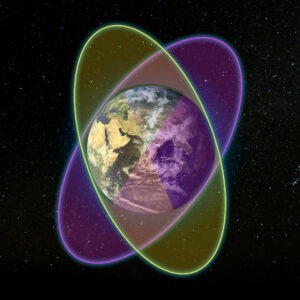Während sich viele von uns beim GPS auf ihre Smartphones...
WeiterlesenWhen we think of location determination, global navigation satellite systems (GNSS) such as GPS often come to mind. These systems have revolutionized the way we navigate, find locations, and manage logistics. However, GNSS is not the only system out there. Various other systems and methods are used to determine positions on Earth, each meeting unique needs and contexts where GNSS may have limitations. Let’s take a closer look at these alternative systems and understand their role and popularity compared to GNSS.
The basics - How does GNSS/GPS work?
GPS is based on a network of satellites that orbit the Earth and continuously send out signals. These are received by GPS receivers on the ground. To calculate an accurate position, a GPS receiver needs signals from at least four satellites. Each satellite sends signals with precise time information and its own orbital parameters.
A detailed description of how the GPS position is determined is explained in our article How GPS Works: How Your Device Knows Where You Are
Alternative systems for positioning
The following list shows a number of methods for determining a position. Depending on the context, an exact position is not necessarily defined by an accurate combination of longitude and latitude, but describes a precise location.
1.
Inertial Navigation Systems (INS)
Description
INS (Inertial Navigation Systems) uses sensors that detect changes in speed and direction to track the position of an object from a starting point. Imagine if you were blindfolded and started walking – based on your steps, you could estimate how far and in which direction you have moved.
Use cases
This type of positioning system is used in aircraft, submarines, missiles, among others. It helps ensure that objects know their location even when they cannot rely on external signals. This applies to environments such as underwater or in space.
Popularity
INS has a high popularity in specialty applications. However, it is not usually found in devices used in everyday life.
2.
Location based on the mobile network
Description
This system uses signals from cell towers to determine your location. Your smartphone connects to nearby towers and by measuring the signal strength combined with the time, your position can be estimated.
Use cases
This type of positioning helps your smartphone locate you for maps and emergency services. This works especially well in cities with lots of cell towers.
Popularity
This system is very popular because it is used in almost every smartphone to get an initial approximation of the current location. This is then usually corrected or made more precise at a later point in time using a “correct” GPS signal.
3.
Wi-Fi positioning systems (WPS)
Description
WPS determines your location based on known locations of Wi-Fi hotspots. Your device scans for Wi-Fi networks in your area and can estimate where you are based on knowing the locations of those networks.
Use cases
Commonly used indoors in locations such as shopping malls and airports where GPS signals may be weak.
Popularity
There is a high popularity in indoor use cases.
4.
Bluetooth Low Energy (BLE) Beacons
Description
BLE beacons are small devices that transmit signals over short distances. By measuring the signal strength, your device can figure out how close you are to a beacon.
Use cases
Used in stores, museums, and indoor navigation systems to provide precise location services, such as guiding you to a product on a shelf.
Popularity
Popularity is increasing, especially in retail and consumer applications.
5.
Radio Frequency Identification (RFID)
Description
RFID uses small tags that emit radio signals. When these tags are near a reader, they can be identified and tracked. Think of it like a more advanced barcode that doesn’t have to be visible to be scanned.
Use cases
Tracking items in warehouses, inventory management and access control to buildings.
Popularity
This method is very popular in inventory and logistics applications.
6.
Ultra Wide Band (UWB)
Description
UWB technology uses very short radio pulses over a wide range of frequencies to measure precise distances. It’s like letting out a short scream and measuring how long it takes to hear the echo.
Use cases
Used in industrial environments, smart homes to control devices, and to track athletes in sports for performance analysis.
Popularity
Increasing, especially in applications that require high precision and short range.
7.
Loran (Long Range Navigation)
Description
Loran is an older system that uses radio signals from fixed transmitters to determine your position. By measuring the time it takes for these signals from multiple transmitters to reach you, you can pinpoint your location.
Use cases
Formerly used for navigation of ships and aircraft, still sometimes used today as a backup for GNSS.
Popularity
Currently rather rare, as Loran has largely been replaced by GNSS, but it can still be found from time to time as a backup system.
8.
Visual Positioning Systems (VPS)
Description
VPS uses cameras and computer vision to compare what you see with a database of images with known locations. It’s like recognizing landmarks to figure out where you are.
Use cases
Used in augmented reality applications (such as Pokémon Go) and for steering autonomous vehicles.
Popularity
With increasing use in augmented reality and self-driving cars, the popularity of this method is growing.
9.
Acoustic positioning systems
Description
These systems use sound waves to determine position, similar to how bats use echolocation. They send out sound signals and measure how long it takes for the echoes to return from surrounding objects.
Use cases
Indispensable for underwater navigation, e.g. for steering submarines and underwater robots.
Popularity
A large proportion of underwater applications are based on these systems. You can find more on this topic in our article Navigation in the Depths: Positioning under Water
10.
Dead Reckoning
Description
This method calculates your current position based on your last known position, using estimates of your speed and direction. It’s like navigating a dark room by tracking your steps and turns from the doorway.
Use cases
Used in tunnels, densely populated urban areas, and by vehicles or robots when GNSS signals are not available. Dead reckoning is often used in calculations related to INS.
Popularity
Highly popular for applications in special contexts, often used as a complement to other methods.
Learn more about how to determine the GPS signal faster and more accurately in our article AGPS – A technology to improve GPS performance
Conclusion
Although GNSS remains the most popular and widely used method of positioning, several other systems are critical in certain contexts where GNSS has limitations. These alternative systems ensure robust and reliable positioning in a wide range of applications, from indoor navigation and underwater positioning to high-precision tracking and autonomous vehicle navigation. By leveraging these complementary technologies, we can achieve accurate and reliable positioning in virtually any environment.
Titelbild: Alexander Ant / pexels
Learn more about how the GPS signal is affected in our article The exact position: What factors influence the GPS signal?
Are you ready to explore GPS tracking solutions for your business or personal use?
Contact us today to discuss the perfect device for your needs!
Or take a look at our online shop.
Related articles
Dinge in Bewegung versetzen: Verstehen, wie sich Navigationssatelliten bewegen
Um eine globale Abdeckung zu erreichen, bestehen GNSS-Systeme aus einem...
WeiterlesenNavigieren in der Tiefe: Positionsbestimmung unter Wasser
Die GPS-Technologie, wie wir sie kennen, hat eine erhebliche Einschränkung:...
Weiterlesen



